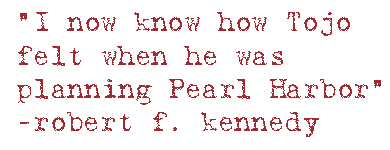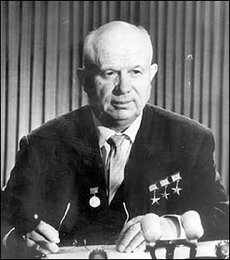Tuesday, 16 October 1962
On the morning of the 16th, President Kennedy called in his senior advisors for an “off-the-record” meeting that would become the basis of the Executive Committee of the National Security Council. During this meeting, the President, principal advisors, and the generals had to determine what the Soviets were doing in Cuba. They developed potential courses of action including planning for air strikes and inv asion (even under false pretenses)7 , diplomatic measures, and a naval blockade.8
asion (even under false pretenses)7 , diplomatic measures, and a naval blockade.8
At this point, Kennedy held the initiative. He knew information about a secret Soviet project to place missiles in Cuba. It was up to him to decide when to act and how to act on behalf of the United States. What Kennedy did not know, however, was whether the Soviets were aware he knew or if intended for him to find out about the project. Kennedy became confident that the Soviets were operating in secret, and did not know that the United States was aware of the project, when he met with Soviet Foreign Minister Gromyko the next day.
During this stage of the crisis, Kennedy had a limited amount of time to determine the United States’ response and to unify the information campaign that would be required to win international support for whatever the United States would decide. The United States would use this time to their advantage.
Meanwhile, in the Soviet Union, the United States Ambassador to the Soviet Union, Foy Kohler, met with Chairman Khrushchev and discussed the U2 incident of 30 August 1962, the unfortunate timing of the Cuba-Soviet Fisheries Agreement, the nuclear test ban, the recent summit in Vienna, and the upcoming American elections.9 Khrushchev was an adept politician and was keenly aware of the impact of the November mid-term Congressional elections to the Kennedy Administration. Due to Khrushchev’s sensitivity to the elections, he was not going to disclose the decision made in May 1962 to deploy Soviet missiles to Cuba until at least November 6, 1962 after which he intended to inform Kennedy himself. 10
Khrushchev made a risky decision to support the Castro regime. Castro declared that Cuba was Communist in 1961. Six months later, Khrushchev decided to send nuclear weapons to protect Cuba from aggression from the United States. Khrushchev knew he did not have the ability to wage a war from Cuban soil, several thousand miles from the Soviet Union, and he felt that nuclear weapons were the best option available. At the same time, Khrushchev did not desire to unduly worsen Soviet-American  relations. Khrushchev balanced the risks inherent in covert operations with a desire to maximize time for supporting Castro. Khrushchev hoped to secretly install the missiles and then, in an effort to minimize misunderstanding, discuss the weapons with Kennedy directly.
relations. Khrushchev balanced the risks inherent in covert operations with a desire to maximize time for supporting Castro. Khrushchev hoped to secretly install the missiles and then, in an effort to minimize misunderstanding, discuss the weapons with Kennedy directly.
Unfortunately for Khrushchev, his risks were realized without the gain. Khrushchev didn’t know it, but the opportunity to establish his message to Kennedy first was lost when the United States discovered the missile sites.

